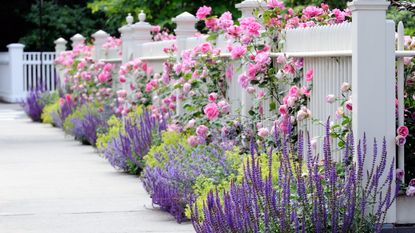5 steps to perfect front yard flower beds - landscape designers explain
Follow these simple steps to achieve the sort of flower beds at the front of your house you thought you could only dream of


When it comes to designing the front yard it can feel overwhelming. This is the first impression people have of your home, it needs to be right. With this pressure, people tend to play it safe with plants, or not try at all. Leaving a rather bland-looking frontage to your home.
But it needn't be this stressful. You should view your front yard as an opportunity to express yourself. A space where you can extend your personal style to nature and adorn your home. It is easy once you know that there are no hard and fast rules. 'By following a few simple guidelines, you will find it nearly impossible to make a mistake,' says horticulturist and botanical designer, Nathan Heinrich.
Two landscape designers have revealed their 6 guidelines to follow when designing a flowerbed in front of the house, providing plenty of modern front yard ideas. These simple steps will guide you through the process to create a front yard that looks expensive and professional.
1. Look at your house
When designing your flower bed it is important to consider the style of your home. Every home has a specific architectural style and the goal of landscaping is to enhance and complement the unique style and design of the home's façade, explains Nathan. 'For example, if you have a cottage-style house you will want to avoid harsh modern landscaping styles,' he says. 'Rather, you're going to want to play with a softer and more romantic aesthetic to play up the traditional elements of your home.'
If you are new to gardening or unsure what type of style suits your home, try looking for inspiration. 'Gardening is an art form and like Pablo Picasso said, "Good artists copy, great artists steal". So give yourself permission to borrow or "steal" inspiration from gardens you love,' says Nathan. Search online for modern garden ideas, and look in magazines. You can even visit neighbourhoods with homes that have similar styles to yours, and make a note of what you like and what garden design choices complement that specific style of architecture.
2. Consider the lighting

Sun exposure will dictate the types of plants you can incorporate in your front yard. Whether you have a North or South facing front yard will play a big role in the design process. 'Nothing is more discouraging to a new home gardener than planting the wrong plants which then struggle to survive and eventually die because they were planted in the wrong location,' explains Nathan. To avoid this tragedy, pay attention to the sun.
If your front yard is south-facing and gets sun all day you will want to focus on including the best plants for a dry garden. Ornamental grasses and succulents make a great choice as they are striking and thrive in hot and dry climates.
Conversely, if you happen to have a north-facing garden you should look at shade-loving plants such as ferns and hydrangeas, and other shady garden ideas. Ensuring you are planting the right plants for your environment is the easiest way to make your front yard look professionally designed.
3. Mix it up
'Choose a mix of perennials that bloom at different times of the year and evergreen shrubs,' says Jarema Osofsky, also known as the Dirt Queen NYC, a Brooklyn-based landscape and interior plant designer. This maintains a level of interest in your front yard throughout the year, even in winter. This ensures there is never a period of complete nothingness. There are plenty of options when it comes to plants for autumnal color, Japanese anemones are a personal favorite.
4. Play with layers and textures

When thinking about your flowerbed the professionals advise thinking of it in three parts: structure, layers, and texture. These are the foundational principles of most landscaping ideas that will give your space more of an interesting composition.
'The best way to design an empty garden bed is to figure out the shapes of plants you want,' says Nathan. He suggests making a rough layout of the structure before you plant anything. 'Draw a rough sketch of the general layout you feel would balance and enhance the front of your home,' he says. Even if you want an effortless, un-fussy flower bed you should check to see if everything looks balanced.
Next, think about texture. 'I like to play with form and texture,' says Jarema, 'like mixing fine textured leaves with bolder, broader foliage.' This will add depth and interest to your flowerbed, leaving no empty spaces. A well-designed yard has a balance of different features that all work in harmony. This will come through trial and error so try things out in a mood before you commit to planting anything.
One thing you should never do when creating your flower bed is plant in straight rows. See it like a cake, the more layers the better. 'The best thing you can do is build undulating layers of plants with varying heights and shapes to create depth and dimension,' she explains.
5. Decide what kind of gardener you are
Lastly, and possibly most importantly, consider what type of gardener you are. If you are an avid gardener who enjoys pottering in the garden at weekends, a wider range of plants will be available. If, however, you would consider yourself to have a "black thumb" you should stick to low-maintenance plants for the front yard. 'Be honest with yourself and the type of gardener you are, rather than the type of gardener you wish you were,' says Nathan, 'this will guide you to choose the best flowers and plants for the beds in the front of your home.'
What to buy for designing your ideal flowerbed

Published: 2012
Price: $22.99

Size: 12.99"(L), 1.97"(H) x 3.15"(W)
Price: $9.99

Size: 1 gallon
Price: $44.95
Be The First To Know
The Livingetc newsletter is your shortcut to the now and the next in home design. Subscribe today to receive a stunning free 200-page book of the best homes from around the world.

Amy recently completed an MA in Magazine Journalism at City, University of London, with experience writing for Women’s lifestyle publications across arts, culture, and beauty. She has a particular love for the minimalist aesthetic mixed with mid-century furniture, especially combining unique vintage finds with more modern pieces. Her previous work in luxury jewellery has given her a keen eye for beautiful things and clever design, that plays into her love of interiors. As a result, Amy will often be heard justifying homeware purchases as 'an investment', wise words to live by.
-
 The 12 Best Table Lamps for Reading —I'm a Certified Bookworm (and Shopping Expert)
The 12 Best Table Lamps for Reading —I'm a Certified Bookworm (and Shopping Expert)When it comes to table lamps for reading, I don't mess around. If you're the same, this edit is for YOU (and your books, or course — and good recommendations?)
By Brigid Kennedy Published
-
 "It's Scandi Meets Californian-Cool" — The New Anthro Collab With Katie Hodges Hits Just the Right Style Note
"It's Scandi Meets Californian-Cool" — The New Anthro Collab With Katie Hodges Hits Just the Right Style NoteThe LA-based interior designer merges coastal cool with Scandinavian simplicity for a delightfully lived-in collection of elevated home furnishings
By Julia Demer Published

